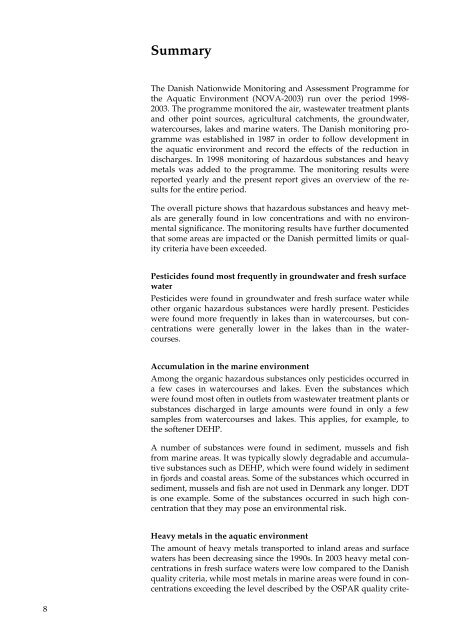Miljøfremmede stoffer og tungmetaller i vandmiljøet - Danmarks ...
Miljøfremmede stoffer og tungmetaller i vandmiljøet - Danmarks ...
Miljøfremmede stoffer og tungmetaller i vandmiljøet - Danmarks ...
Create successful ePaper yourself
Turn your PDF publications into a flip-book with our unique Google optimized e-Paper software.
8<br />
Summary<br />
The Danish Nationwide Monitoring and Assessment Pr<strong>og</strong>ramme for<br />
the Aquatic Environment (NOVA-2003) run over the period 1998-<br />
2003. The pr<strong>og</strong>ramme monitored the air, wastewater treatment plants<br />
and other point sources, agricultural catchments, the groundwater,<br />
watercourses, lakes and marine waters. The Danish monitoring pr<strong>og</strong>ramme<br />
was established in 1987 in order to follow development in<br />
the aquatic environment and record the effects of the reduction in<br />
discharges. In 1998 monitoring of hazardous substances and heavy<br />
metals was added to the pr<strong>og</strong>ramme. The monitoring results were<br />
reported yearly and the present report gives an overview of the results<br />
for the entire period.<br />
The overall picture shows that hazardous substances and heavy metals<br />
are generally found in low concentrations and with no environmental<br />
significance. The monitoring results have further documented<br />
that some areas are impacted or the Danish permitted limits or quality<br />
criteria have been exceeded.<br />
Pesticides found most frequently in groundwater and fresh surface<br />
water<br />
Pesticides were found in groundwater and fresh surface water while<br />
other organic hazardous substances were hardly present. Pesticides<br />
were found more frequently in lakes than in watercourses, but concentrations<br />
were generally lower in the lakes than in the watercourses.<br />
Accumulation in the marine environment<br />
Among the organic hazardous substances only pesticides occurred in<br />
a few cases in watercourses and lakes. Even the substances which<br />
were found most often in outlets from wastewater treatment plants or<br />
substances discharged in large amounts were found in only a few<br />
samples from watercourses and lakes. This applies, for example, to<br />
the softener DEHP.<br />
A number of substances were found in sediment, mussels and fish<br />
from marine areas. It was typically slowly degradable and accumulative<br />
substances such as DEHP, which were found widely in sediment<br />
in fjords and coastal areas. Some of the substances which occurred in<br />
sediment, mussels and fish are not used in Denmark any longer. DDT<br />
is one example. Some of the substances occurred in such high concentration<br />
that they may pose an environmental risk.<br />
Heavy metals in the aquatic environment<br />
The amount of heavy metals transported to inland areas and surface<br />
waters has been decreasing since the 1990s. In 2003 heavy metal concentrations<br />
in fresh surface waters were low compared to the Danish<br />
quality criteria, while most metals in marine areas were found in concentrations<br />
exceeding the level described by the OSPAR quality crite-

















